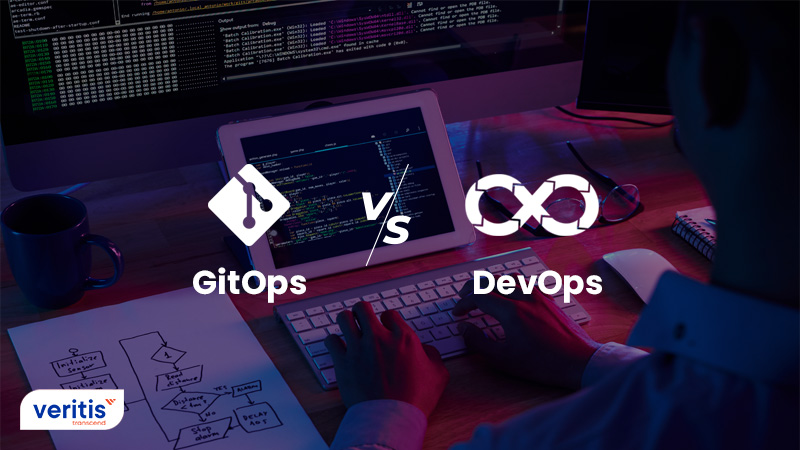
The digital landscape is ever-evolving. From cloud technology to DevOps, companies have come a long way. One of the new practices that has arisen recently is GitOps.
Founded on a set of practices that allow developers to perform many more IT tasks, GitOps has gained a reputation for fostering seamless innovation. Although relatively new, companies have taken cognizance of this new approach and incorporated it into their production processes.
So, what exactly is this approach? Let’s find out.
What is GitOps?
As apparent, GitOps is based on the open-source platform Git. It is a methodology that simplifies continuous deployment and Git applications infrastructure management. In short, it is a set of practices developed specifically for Git application operations, hence the name.
This practice allows users to verify and deploy infrastructure changes. Additionally, all the configurations are stored in a repository compatible with Git. With this centralized repository, developers can make configuration changes and overview the history of changes.
Also, GitOps betters the deployment process as one can integrate the infrastructure with the same delivery pipelines. This makes application management the core aspect of the GitOps software delivery process.
Useful Link: EKS Vs. AKS Vs. GKE: Which is the right Kubernetes platform for you?
Core Practices of GitOps
GitOps was first coined by the co-founder of Weaveworks, Alexis Richardson. The methodology evolved from its inception, and it now has three core practices on which it operates.
Complete Declarative Infrastructure
With this approach, all infrastructure configurations are perceived to be declarative and to be treated as code. This declarative nature allows users to proceed with the automated provisioning tools to construct an optimal infrastructure. It also lends the required flexibility to initiate rollbacks without any disruptions.
The Repository is the Key
GitOps is gaining traction due to the innovative idea that all Git configurations are stored in one place. This allows the Ops team to view and track every change and addition incorporated into the infrastructure. This transparency provides swift auditing and better decisions, which may include rollbacks.
Automated Updates
Updating manually is expensive in resources and time. GitOps eliminates this expense, as the infrastructure is improved with automated updates that don’t require manual intervention. In addition, the consolidated storage of the configuration allows the entire infrastructure to be updated in one go.
Schedule A Call With Our DevOps Expert
Useful Link: AWS Vs Azure Vs GCP – The Cloud Platform of Your Choice?
As one may observe, GitOps is similar to DevOps. However, there are subtle differences between both approaches. Let’s explore what they are.
How GitOps is different than DevOps

DevOps and GitOps are both practices that streamline development and deployment processes. However, the primary distinctive feature that GitOps possesses over DevOps is that while DevOps was designed to suit various other cultures, GitOps focuses specifically on operations that run on Git.
While DevOps introduces a fundamental cultural change in the company, GitOps brings the required tools and practices to infrastructure management. These tools foster collaboration, enable better development and deployment, and bolster the CI/CD pipelines.
As GitOps is much more focused on infrastructure, it is more rigid and perfection-oriented than DevOps. However, it is much more compatible with K8s, while DevOps makes up for that in other areas, such as easy supply chain management.
As one may have observed, GitOps is an extension of DevOps. The former can complement the latter for a more reliable development environment that houses applications and infrastructures.
Useful Link: Signs of a Failed DevSecOps Strategy Which None Should Ignore
How to get started on GitOps

GitOps doesn’t demand drastic changes in the working culture or the development process. The only change that the company would have to welcome is that the existing infrastructure should be managed with code tools and a Git repository.
The first step is to identify your unique needs, which your infrastructure has provided. Then, based on that information, the company can integrate its existing structure with information-as-code tools. However, the company can also prefer to start from scratch. Both approaches have their own merits. While integration saves time, starting from scratch is advised to support various new projects that a company may encounter.
As one can observe, GitOps strengthens the organization with various abilities. From reduced errors to the increased yet productive focus on Git, organizations of various scales are reaping the benefits. However, it is an uphill challenge to identify the infrastructure’s needs correctly and decide whether to start from scratch or proceed with integration.
This is where Veritis steps in for our clients. First, we inspect and inform you how best to proceed with an idea. Then, by identifying your unique needs, we create a solution that suits you best. So, reach out to us and let us help you embrace the power of GitOps!
Explore Devops Services Got Questions? Schedule A Call
Additional Resources:
- DevOps Configuration Management: A Guide to the Top Tools in the Field
- Demystifying MLOps vs DevOps: Understanding the Key Differences
- AIOPS Solutions: Enhancing DevOps with Intelligent Automation for Optimized IT Operations
- DevOps vs DevSecOps: Approaches Which Amplify Automation and Security
- A Guide to DevOps Implementation on Google Cloud
- DevOps on AWS: An Introduction on How to Integrate Seamlessly